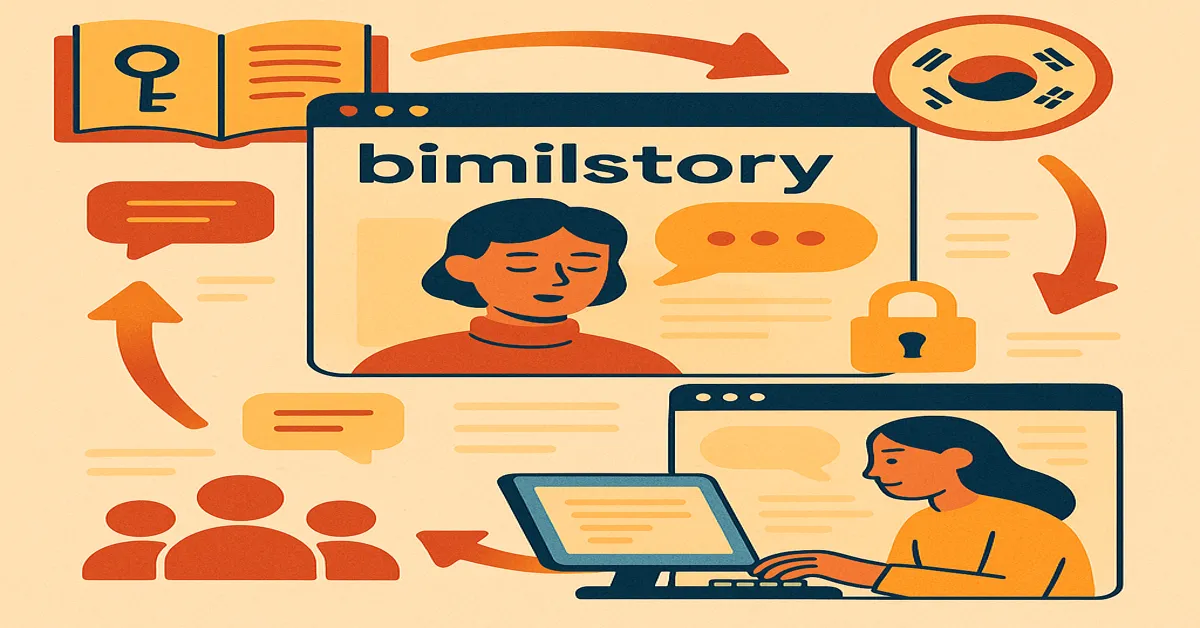In the fast-paced universe of online media, the keyword “bimilstory” has started to echo across content platforms, yet its meaning isn’t immediately obvious. What is bimilstory? Is it a website, a storytelling format, a social persona, or something more abstract? To answer this question directly: bimilstory is an emerging digital term symbolizing secret, serialized storytelling in an interactive, audience-driven format. But its meaning is layered, flexible, and evolving in real-time.
This article explores “bimilstory” not just as a name or tool, but as a cultural artifact—something born from our collective hunger for immersive narratives and evolving media technologies. Whether you’ve encountered the term once or a hundred times, here’s what you need to know.
Understanding the Term “Bimilstory”
To begin, let’s break down the word itself:
- “Bimil” (비밀) is a Korean word that means “secret”.
- “Story” is universal—representing a narrative, a recounting of events, real or fictional.
So, “bimilstory” can be interpreted as “a secret story”, or more contextually, “hidden narratives” that are revealed over time.
This structure is critical. The term doesn’t imply just a story—it implies a concealed narrative, often revealed episodically, slowly, and sometimes interactively. It immediately evokes mystery, digital intimacy, and narrative play. It suggests an audience who must follow clues, make interpretations, or even participate to uncover the full picture.
The Format — A New Kind of Serial Fiction?
While bimilstory may sound like a title or name, it also describes a format that is gaining popularity across platforms like Webtoon, TikTok, serialized apps, and even private newsletters. These formats often:
- Deliver content in small, timed releases (think daily episodes or journal entries).
- Invite audience participation through comments, votes, or interactive choices.
- Maintain secrecy or cryptic language, drawing viewers deeper into the narrative.
- Encourage direct creator-to-audience relationships, often with blurred lines between fiction and reality.
In this way, bimilstory is both a narrative structure and an experience. Readers or viewers are not passive—they are detectives, confidants, or even co-authors.
The Aesthetic of Bimilstory
Unlike mainstream serialized content, bimilstory projects are often characterized by a raw, lo-fi, and minimalist aesthetic. Think hand-written fonts, diary-like text, pastel tones, and grainy photos. Sometimes, they adopt the appearance of private messages, screenshots, or voice memos.
This intimate style enhances the emotional depth and invites the audience to suspend disbelief. Is this a real person’s secret? A fictional character? A dramatized account of a true story?
Bimilstory projects leverage the ambiguity to create a sense of voyeurism and personal connection. The audience becomes emotionally invested not just in what happens, but in how the story is told.
Cultural Roots and the Korean Influence
As the name suggests, bimilstory has strong Korean linguistic and cultural underpinnings. Korea has long been a leader in serialized digital storytelling—through web novels, webtoons, idol fanfiction, and interactive visual novels.
The concept of secret-sharing is deeply embedded in Korean youth culture:
- “비밀 계정” (secret account) is used by many teenagers for Finstas or private social profiles.
- “고백 스토리” (confession story) thrives in school apps and anonymous confession boards.
- Web novels and manhwa often use serialized cliffhangers and multiple timelines to deepen engagement.
Bimilstory draws from these elements but modernizes them—infusing global storytelling with Korean-inspired intimacy and digital aesthetics.
Where Bimilstory Lives
Unlike legacy storytelling formats, bimilstory isn’t restricted to one platform. It lives across various digital spaces:
1. Short-form Video Apps (TikTok, Reels)
Creators post serial content in short clips, with each video advancing the story or complicating the mystery. Often, comments influence the next post.
2. Web Novel Apps
Serialized apps allow for secret diaries, letters, or mystery threads to unfold. Some even offer in-story choices, giving users narrative agency.
3. Private Newsletters or Subscriptions
Some bimilstory creators distribute entries via email or Patreon. This format mimics old-school pen-pal intimacy but in a modern, structured arc.
4. Hidden Social Media Pages
Instagram stories, alternate Twitter accounts, or hidden TikTok hashtags act as fragments of larger bimilstories. They require the audience to piece things together.
The key element is audience immersion—bimilstory projects often rely on layered content that invites exploration and speculation.
Why It’s Gaining Popularity Now
Several converging trends explain the rise of bimilstory:
- Burnout from mass content: People are tired of bingeing 12-hour shows. They want short, meaningful engagement.
- Craving intimacy online: In an era of polished influencer content, users crave vulnerability, mystery, and human messiness.
- Interactive fiction revival: Games like Life is Strange and Choice of Games have revived interest in player-driven narratives.
- Cultural globalization: Korean media has exploded globally. Terms like “bimil” gain traction as audiences embrace K-dramas, K-pop, and Korean apps.
Bimilstory aligns perfectly with these shifts. It offers a slow, intimate, mysterious counterpoint to the algorithmic firehose of mainstream social feeds.
The Business of Bimilstory
While the term evokes indie creativity, there is an emerging economy forming around it.
Writers, illustrators, and content creators are packaging bimilstories for:
- Exclusive subscription communities
- Collaborative fan-driven franchises
- Paid app experiences
- NFT-based or tokenized storytelling (Web3)
Some brands are experimenting with bimilstory-style marketing—telling their brand journey as a cryptic, immersive tale that unravels across social media. This format can be powerful for customer loyalty, narrative branding, and emotional storytelling.
Is Bimilstory Fiction or Reality?
One of the most captivating aspects of bimilstory is that it often blurs the line between reality and fiction. This narrative style may include:
- Real photos and voice messages.
- Diary-style writing.
- Mixed media: video, audio, chat logs, emails.
These elements create an emotional realism that makes even fictional stories feel autobiographical. It’s storytelling not just with plot, but with texture and digital intimacy.
Readers often wonder: “Is this real?” And that question is part of the experience.
The Psychological Hook
Bimilstory works because it plays on psychological patterns:
- Curiosity gap: Secrets make us lean in.
- Fragmented narratives: Our brains are wired to complete stories when given clues.
- Parasocial bonding: We form one-sided relationships with fictional narrators.
- Micro-investments: With 1-minute reads or videos, engagement feels light—but builds fast.
These elements make bimilstory sticky, viral, and highly shareable.
Risks and Concerns
With every digital trend, there are ethical questions:
- Misinformation: Some fictional bimilstories go viral as real-life events, creating confusion or panic.
- Emotional manipulation: Certain creators use trauma or taboo topics for clicks, without proper warnings or context.
- Plagiarism and anonymity: Many bimilstory projects are uncredited, and authorship becomes murky.
As the format grows, platforms may need to distinguish fictional bimilstories from real-life claims, especially when shared widely.
What the Future Holds
Bimilstory is not just a passing trend—it’s a narrative movement. It reflects how younger generations consume and create stories:
- Interactive.
- Emotionally authentic.
- Visually minimal.
- Technologically fluid.
It’s part of a larger shift toward decentralized storytelling, where stories are co-created, discovered, and experienced in non-linear formats. Expect to see bimilstory integrated into AR experiences, podcasts, apps, and education.
It’s a new language—one we’re still learning how to read.
Conclusion: What Is the Meaning of Bimilstory?
In the simplest terms, bimilstory is a form of secret-driven, serialized digital storytelling born from Korean language and global internet culture.
In a deeper sense, it’s about emotional connection, mystery, and nonlinear narratives. It’s a story you follow in fragments, a puzzle you solve with strangers online, and a character you believe in—real or not.
Whether you’re a writer, marketer, educator, or simply a curious reader, bimilstory signals something new: a quiet revolution in how stories are told and felt.
Read: Sodziu: The Evolution of a Cultural Identity in a Globalized World
FAQs
1. What is bimilstory?
Bimilstory is a storytelling format rooted in digital culture, combining the Korean word “bimil” (secret) with “story.” It refers to serialized, often mysterious narratives shared through digital platforms like TikTok, web novels, or hidden social accounts. These stories are typically emotional, fragmented, and immersive, inviting readers to uncover hidden meanings or follow cryptic plots over time.
2. Is bimilstory a person, platform, or concept?
Bimilstory is not a specific person or single platform. It is a narrative concept and format that can appear on multiple digital channels, from short-form video apps to newsletters or Instagram pages. It emphasizes personal, emotional storytelling — sometimes fictional, sometimes real — often told in a cryptic or secretive style.
3. Where can I find or read bimilstories?
Bimilstories can be found across various digital spaces, including:
- TikTok or Instagram series
- Web novel and storytelling apps
- Private newsletters or Patreon posts
- Anonymous or hidden social media accounts
Because secrecy and discovery are central to the experience, part of the appeal is stumbling upon or being invited into a bimilstory rather than seeking it through traditional channels.
4. Why are bimilstories becoming popular now?
Bimilstories resonate with modern digital audiences because they offer:
- Intimate, emotionally raw content
- Bite-sized, easy-to-follow episodes
- Mystery and interactive engagement
- A break from overly polished, commercial storytelling
In an age of algorithmic saturation and content overload, audiences are drawn to formats that feel personal, mysterious, and emotionally honest.
5. Are bimilstories real or fictional?
They can be either — or both. Some bimilstories are fully fictional but told in a realistic, diary-style format. Others are based on real events or personal confessions. Often, creators blur the lines intentionally, enhancing mystery and audience immersion. Always engage thoughtfully and be mindful of boundaries between entertainment and emotional authenticity.











